I mentioned in my Table Mountain post that the fynbos is an area of high biodiversity. I didn't mention that this area is adapted to fire and that burns on a regular basis are important for maintaining that biodiversity. If burns are too frequent (less than five years, for example), the fynbos loses diversity because the vegetation can't recover sufficiently to reseed. Burns that are too infrequent cause another type of problem - too much biofuel available to burn and the heat becomes so great that the vegetation can't recover. Burns every 10-15 years seem to be about right for maintaining the biome. The burn at Kirstenbosch happened less than six months ago and it's pretty amazing to see how fast the fynbos is recovering.

Our walks up to the contour path start on the Stinkwood trail - named not because the woods stink here, but after a tree with a common name of stinkwood. This is an indicator tree of the recovery of the afromontane forest on the flanks of Table Mountain. This area's forests had been decimated during the colonial era and then converted to pine and gum tree plantations. A recovery program was initiated a couple of decades ago and the afromontane forest is making a nice comeback. This is the same route we had taken during our tree walk with the Western Cape Woodturners Association. Dennis Laidler posted a lot of good information about the forest on his posting of this tree walk.
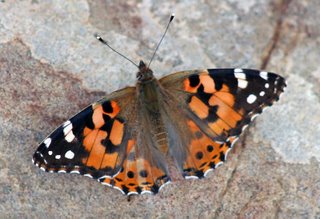
This butterfly was foraging at the bottom of the trail, in Kirstenbosch botanical garden.

This group of wood mushrooms was on a decaying tree at the top of the trail where it meets the contour path.

They're not colorful, but are photogenic none-the-less. Fungi play an integral role in recycling nutrients into the ecosystem.
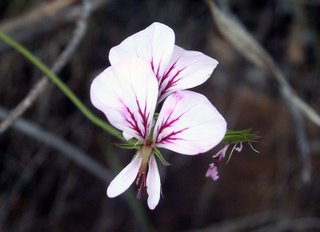
I have a new graduate student who will be doing his dissertation on the genus Pelargonium, a genus with about 350 species in South Africa. There are two very prominent species on the contour path. This one is Pelargonium myrrhifolium.

Pelargonium cucculatum. This is all over the hillsides on the Cape Peninsula and on the road from Gordon's Bay to Hangklip.

Another plant that is all over the moist areas of the contour path is the sundew (Drosera hilaris). a carnivorous plant. This is a hard plant to photograph with the long, spindly stem of the flower.

It's very pretty, though.
 The burn area presents a dramatic landscape against the backdrop of Table Mountain. After just a few months time, the vegetation is bouncing back spectacularly. The first plants to emerge are the geophytes (plants with bulbs and corms) that have been waiting for the perfect opportunity. Here the hillside is in bloom with plants from the Iris family such as Watsonia (in pink) and Aristea (in blue).
The burn area presents a dramatic landscape against the backdrop of Table Mountain. After just a few months time, the vegetation is bouncing back spectacularly. The first plants to emerge are the geophytes (plants with bulbs and corms) that have been waiting for the perfect opportunity. Here the hillside is in bloom with plants from the Iris family such as Watsonia (in pink) and Aristea (in blue).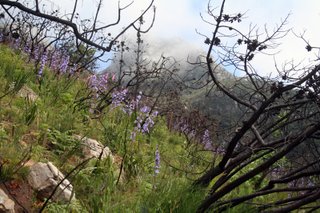
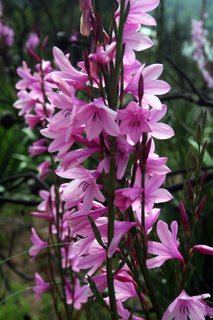
I think the Watsonia growing all over the burn site is W. pyrimidata.

It's a pretty thing with large pink flowers.

Some of the flowers are almost white with pink highlights.
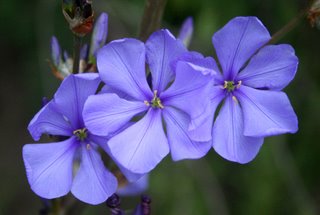
This is probably Aristea africana.

One of the impressive things to see at the burn site is the resprouting that is going on with the different species of shrubs that are adapted to fire. You see new shoots arising from the root stocks as in this photo. . .

and in this one,

or from the nodes of the branches as in this photo.

This interesting plant is a fern called Schizaea pectinata, or toothbrush fern. The fertile fronds are those brown comb-like structures.

The fertile fronds are very interesting.

This fern has a large distribution from South Africa to Malawi, St. Helena and Madagascar.

I'm not sure, but I think this is Ixia polystachya.

Detail of the Ixia.

Most of the plants seen at Kirstenbosch on the contour plath are native to the region. However, this one is an invasive species, Hibiscus trionum.

The plant is native to Europe and has become a noxious weed in many parts of North America and, presumably, South Africa as well.
I also took some photos of animals on this walk and on the second walk later in the day.

I have no idea as to the species of this moth, but she's laying eggs on the leaf of this plant.

The carpenter bees at Kirstenbosch are about the size of small hummingbirds. They sound like helicopters when they buzz you.

This is a juvenile grass sparrow perching on a twig up near the contour path.
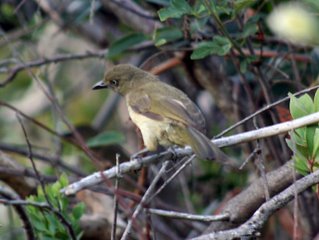
And this is a Somber Bulbul. These birds have a very loud song and it's often hard to find where they are hiding in the bush.




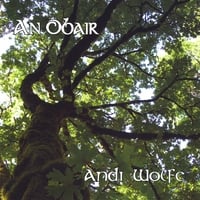






No comments:
Post a Comment